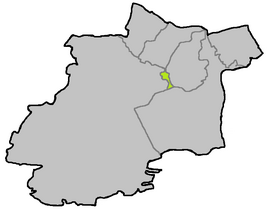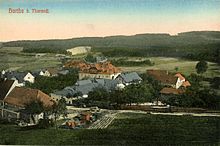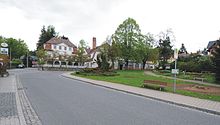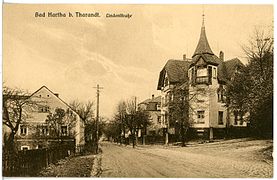Hartha health resort
|
Hartha health resort
City of Tharandt
Coordinates: 50 ° 58 ′ 49 ″ N , 13 ° 32 ′ 40 ″ E
|
|
|---|---|
| Height : | 349 m |
| Area : | 4.26 km² |
| Residents : | 1986 (Dec. 31, 2013) |
| Population density : | 466 inhabitants / km² |
| Incorporation : | January 1, 1999 |
| Postal code : | 01737 |
| Area code : | 035203 |
|
Location of the "Hartha mit Spechtshausen" district in Tharandt
|
|
Kurort Hartha is an official health resort a village and one of the main places of the Saxon town of Tharandt in District Saxon Switzerland-Eastern Ore Mountains . In addition, the place forms a district of the same name in the city of Tharandt. Partner community is houses since 1990 .
geography
location
The health resort has an area of approx. 4.26 km² and is located northeast of the Tharandt forest on Todbach . The Scheibenbach rises north of the village . The population density is about 474 inhabitants per square kilometer.
Neighboring places
| Spechtshausen | Fördergersdorf | |
| Grillenburg |

|
Tharandt |
| Tharandt |
District
The district Kurort Hartha consists of the district Hintergersdorf with the settlements Waldhäuser and Kuckuck (locality Tharandt) and part of the districts Hartha with Spechtshausen or Grillenburg and Fördergersdorf.
history

Hintergersdorf, today's lower village of Kurort Hartha, was laid out as a forest hoof village and is said to have been created in 1205 by the colonist of Meißner bishop Bruno II of Porstendorf , Gerhardus miles de Kezcelesdorph , mentioned in a document in 1223 , together with Fördergersdorf . The place under Castrum Tharandt was first mentioned in 1378 as Wengin Gerhartstorf . Hartha, today's Oberdorf, was laid out as a row of houses and was only created around 1540 by the settlement of seven Zeidlers (later referred to as old gardeners ) as forest beekeepers and forest overseers with their own jurisdiction on Hartheberg, who are first mentioned in 1542 (Latin harth = mountain forest). From 1550 to 1856 Hartha was part of the Tharandt-Grillenburg office, then the Tharandt court office. The Hintergersdorfer settlements Waldhäuser and Kuckuck emerged in the 18th century, the latter in the Tharandt area. The parish of Hartha and Spechtshausen existed since 1829. In 1837 Hartha was parish in Fördergersdorf. In 1869, Hartha and Spechtshausen became a resort and developed as Bad Hartha from 1870 into a health resort. Since 1875 Hartha was part of the Dresden administration . From 1904 Hartha became a climatic health resort . In 1926 the health resort Hartha merged with Spechtshausen and Hintergersdorf voluntarily to form the health resort Hartha-Hintergersdorf. In 1933 it was renamed to the current place name Kurort Hartha. After 1945 Spechtshausen belonged to Fördergersdorf. From 1952 the place was a municipality in the Freital district , later a district . On January 1, 1973 Fördergersdorf and Grillenburg were incorporated, and the health resort Hartha and all districts received the title of state-recognized resort . On August 1, 1994, Kurort Hartha became part of the Weißeritzkreis, which was formed from the Freital district and the Dippoldiswalde district . On January 1, 1999, the health resort's independence ended when it merged with Pohrsdorf and Tharandt to form the town of Tharandt. In December 2010 it was again recognized by the state as a resort.
Development of the population
- 1551: 7 possessed men, 7 residents (only Hartha)
- 1764: 10 gardeners, 5 cottagers
- 1834: 131
- 1871: 225 (Hartha with Spechtshausen )
- 1890: 205
- 1910: 268
- 1925: 334
- 1939: 1692 (Kurort Hartha with Hintergersdorf )
- 1946: 2049
- 1950: 1930
- 1964: 1752
- 1990: 2288 (Kurort Hartha with Grillenburg , Hintergersdorf, Fördergersdorf and Spechtshausen)
- 2013: 1986
traffic
In 1900 the innkeeper of the Kurhaus Hartha, Hermann Lehmann, set up a bus service with horse-drawn vehicles between the Tharandt train station and the Kurhaus Hartha. During the summer, six round trips were offered on weekdays and up to twelve on Sundays. In 1902 the Hartha haulier Hugo Opitz took over the Hartha - Tharandt bus service . On July 12, 1912, the power bus line Tharandt - Kurort Hartha - Spechtshausen opened by the Saxon automobile pioneer Emil Nacke (1843–1933), which replaced the horse-drawn bus . After several changes of sponsorship and extension, via Pohrsdorf to Fördergersdorf , it still exists today as line 345 and the oldest bus line still in operation of the regional traffic Saxon Switzerland-Eastern Ore Mountains (RVSOE), but since the timetable change at the beginning of the school year 2012 only to Kurort Hartha, branch Spechtshausen. Further bus connections existed from 1930–2012 on the long-distance bus line Dresden - Annaberg (T 400), which now runs via Hetzdorf , and since 1971 with the line 363 ( Freital -) Tharandt - Klingenberg (- Frauenstein ), which today via Fördergersdorf, Pohrsdorf, Spechtshausen , Kurort Hartha and Grillenburg goes to Klingenberg-Colmnitz station .
Fire extinguishing
The mandatory fire departments of Hintergersdorf and Hartha with Spechtshausen were converted into voluntary fire departments in 1926 and merged in 1927. The historic syringe house in the Hartha community with woodpecker houses from the 19th century has been preserved as a private garage on the corner of Talmühlenstrasse and Lindenhofstrasse. The first motorized sprayer was purchased in 1932 by a private foundation in 1928 and a riser tower was built in 1931, which is now not far from the fire station on Erbgerichtsgasse , which was occupied in 1988 .
Attractions
- Geographical center of Saxony on the district Grillenburg in the Tharandt forest ( Tännichtgrund / Thief Chamber)
- Hennig clock technology teaching show in the former municipal office with one-second walk Tharandt - Spechtshausen (approx. 6 km)
- Gatehouse of the Dresden agricultural exhibition from 1930 on a former agricultural example farm, with fountain, pigeon house and Reuning - Steiger memorial stone from 1926 (Talmühlenstraße 32)
- Concrete art building Dresden by the architectural artist Gerhard Merz in the industrial park on Zeisigweg (solar test laboratory of the Fresenius Institute )
- Bell cage from 1933 with a Marien or peace bell in the forest park, cast in 1517 by Martin Hilliger for the Fördergersdorf church
- Bronze sculpture Hubertushirsch from the Grillenburg castle park on the Kurplatz
- Memorial stone for the 25th anniversary of the reign of Kaiser Wilhelm II , erected in 1913 by the Royal Saxon. Military Association Wettin Hartha u. U. on Waldstrasse
- Hindenburg memorial stone in the garden of the Lindenhof senior citizens' home (Lindenhofstrasse 5), erected in 1915 by military soldiers from the Dr.-Streit rest home (now a primary school)
- Geological open-air museum (circular route approx. 12 km) and geological hiking trail (approx. 4 km) between Mohorn-Grund and Tharandt
- Paths of the songs as a circular route (approx. 5 km) from / to Kurplatz / Waldstraße
- ForstPark and Hedwig's Scent Garden on Zeisigweg as an extension of the Tharandt Forest Botanical Garden
- Landscape protection area Tharandt Forest , which is a geopark of national importance
Personalities
- Mehmed Şükrü Pascha (1856–1916), called Schükri Pascha - hero of Adrianople ( Edirne Müdafii ), brigadier general of the Turkish army, honorary adjutant of the German emperor Wilhelm I in 1887 and deputy military commander in Aleppo in 1909 ; surrendered Adrianople (today Edirne ) to the Bulgarians in the first Balkan War in March 1913 after a siege of several months; Memorial stone from 1913 in the garden of today's Lindenhof senior citizens' home of the Dresden District Foundation in Kurort Hartha (today: Lindenhofstrasse 5)
- Oskar Jobst (born September 25, 1873 in Oelsnitz / Erzgeb. , † January 28, 1962 in Kurort Hartha) - mining engineer, mine director in Gersdorf near Chemnitz; Residence in Kurort Hartha (today: Parkstrasse 6); Tomb in the cemetery in Fördergersdorf
- Bernhard Hantzsch (born January 12, 1875 in Dresden, † probably late May / early June 1911 in Canada on Baffin Island) - teacher in Grillenburg and Dresden as well as ornithologist and Arctic explorer; Namesake of the primary school Kurort Hartha
- Eva von der Osten (born August 19, 1881 on Heligoland , † May 5, 1936 in Kurort Hartha) - German singer (soprano), married to the baritone Friedrich Plaschke (1875–1952); shared residence in Kurort Hartha (today: Talmühlenstr. 49)
- Heinrich Ernemann (born May 28, 1850 in Gernrode , † May 16, 1928 in Kurort Hartha) - German entrepreneur in the photo and cinema equipment industry in Dresden and founder of Ernemann-Werke AG with residence in the Villa Heinrichs Eck in Kurort Hartha (today : Am Hartheberg 21)
- Georg Rudorf (born January 27, 1868 in Bautzen , † February 2, 1948 in Kurort Hartha) - Agriculture Councilor , director of the Quakenbrück agricultural school , called "Ackerdocktor"; reformed agriculture in Artland , Lower Saxony , died in Villa Wilhelmsruhe in Kurort Hartha (today: Am Hartheberg 20)
- Georg Oertel (born March 27, 1856 in Großdölzig, † July 23, 1916 in Spechtshausen) - member of the Reichstag, conservative politician, editor-in-chief of the German daily newspaper in Leipzig ; spent his summer holidays in the tower courtyard in Kurort Hartha; Tomb in the cemetery in Fördergersdorf
- Alvin Anger (born November 29, 1859 in Hamburg, † 1924 in Lindau-Hoyren on Lake Constance ) - architect (including Villa Weigang in Bautzen 1902-03); Professor of shadow theory, perspective and architecture at the Dresden School of Applied Arts (1911: New textbook on perspective ); self-designed residence Landhaus Villa Anger (1901–02), 1924–93 Kurheim of the Deutsche Reichsbahn Villa Harthaberg or Otto Rehschuh , in Kurort Hartha (today: residential house, Am Hartheberg 23)
- Arnold Edmund Streit (born May 10, 1867 in Chemnitz, † June 21, 1940 in Dresden), lawyer, Privy Councilor (1917), 1909–1917 governor of the Dresden-Altstadt district administration , 1929–1932 President of the Saxon Higher Administrative Court in Dresden , author of the Saxon municipal code of 1923, namesake of the Dr.-Streit rest home for school-age children built in 1913 , from 1945 school in Kurort Hartha (today: F.-v.-Schiller-Straße 21)
- Karl Eugen Biebrach (born May 10, 1882 in Dresden ), painter and graphic artist, student of Richard Müller at the Dresden Art Academy , lived in the health resort of Hartha (today: Waldhäuser 32)
- Clemens Eduard Drechsler (born April 4, 1893 in Geyer , † October 8, 1961 in Kurort Hartha), 1924–26 mayor of Hintergersdorf, 1926–33 of Hartha-Hintergersdorf and 1933–36 of Kurort Hartha; since April 3, 1993 honorary citizen of the health resort Hartha for his services to the development as a health resort and recreation area
- Martin Schretzenmayr (born September 17, 1920 in Lenggries , † November 11, 1991 in Kurort Hartha), professor for botany and nature conservation at the University of Jena and the TU Dresden in Tharandt , lived in Kurort Hartha (today: F.-v. -Schiller-Str. 7)
- Walter Kaiser (born December 27, 1923 in Pohrsdorf , † February 18, 1965 in Friedrichshain ), German engineer, first operations manager (technical director) of the Friedrichshain television piston factory and survivor of the sinking of Wilhelm Gustloff , grew up in the former school ( today: Talmühlenstrasse 56) and most recently living in Kurort Hartha (today: Parkstrasse 6)
- Jana Gebhardt (* July 6, 1974, † December 19, 2014), Miss Brandenburg 1993 and initiator of the local Hedwigs Duft-Garten project , most recently lived in the Kurort Hartha, Waldhäuser 53
- Tom Starke (born March 18, 1981 in Freital), soccer goalkeeper, Bayern Munich, grew up in the health resort of Hartha
literature
- Kurt Osk. Clay: from the past and present of the villages of Hartha, Grillenburg, Fördergersdorf, Hintergersdorf, Spechtshausen and Porsdorf near Tharandt. Self-published, 1904.
- Mayor Müller, Hartha (ed.): Prospectus for the health resort Hartha with Spechtshausen. Hartha 1924.
- Edith Wagner: Ortschronik Kurort Hartha. Kurort Hartha community (ed.), 1953.
- André Kaiser: 140 years of the resort - the development of the recreational system in Kurort Hartha. In: Around the Tharandt Forest. Official journal of the city of Tharandt. Edition August 2009.
- Transport and improvement association Tharandter Wald (ed.): Kurort Hartha and surroundings. Geiger-Verlag, Horb 2012, ISBN 978-3-86595-493-0 .
Web links
- Kurort Hartha in the Digital Historical Directory of Saxony
- Website of the spa
swell
- Between Tharandt forest, Freital and the Lockwitztal (= values of our homeland . Volume 21). 1st edition. Akademie Verlag, Berlin 1973, p. 16ff.
- Kulturbund der DDR, local group Tharandt (ed.): The Tharandter forest, forest town Tharandt, contributions to local history. Issue 7, Tharandt 1982.
- André Kaiser: "What the forester said in the evening by the fireplace" - legends from the Tharandt forest. Sächsische Zeitung, Regionalverlag Freital, around 1996, OCLC 312685118 .
- André Kaiser: The Harthaer Glocke, its curriculum vitae and the legends about Warnsdorf In: Harthaer Gemeindeblätt'l. Official journal of Kurort Hartha, December 1992.
- Manfred Hammer: Structurally and historically valuable village complexes in the Weißeritz district. In: Association of rural building values in Saxony eV (ed.): Farmhouses, farms, villages in Saxon districts. Volume 4. Dresden 2006, pp. 106-107.
- André Kaiser: 75 years Kurort Hartha , in: Around the Tharandt Forest - Official Journal of the City of Tharandt, November 2008 edition
- André Kaiser: 140 years of recreation - the development of recreation in Kurort Hartha , in: Around the Tharandt Forest - Official Journal of the City of Tharandt, August 2009 edition
- Lars-Arne Dannenberg , Vincenz Kaiser: Wilsdruff in the High Middle Ages. Considerations for the settlement of the Wilsdruffer Land and the development of the city with special consideration of the Jakobikirche. (= New archive for Saxon history. 80th volume). Verlagdruckerei Schmidt, 2009, ISBN 978-3-87707-769-6 .
- Stephan Klingbeil: Kurort Hartha can call itself a resort again. In: Saxon newspaper. Freital, December 8, 2010.
- Bernd Lichtenberger: A relaxing climate in Tharandt. In: Dresdner Latest News. December 8, 2010.
Individual evidence
- ↑ a b tharandt.de ( Memento from July 21, 2010 in the Internet Archive )
- ^ André Kaiser: Die Zeidler von Fördergersdorf and Hartha. Harthaer Gemeindeblätt'l, Official Gazette of Kurort Hartha, October 1995, p. 6
- ^ Sächsisches Hauptstaatsarchiv Dresden, inventory 10052, Amt Grillenburg and inventory 10036, financial archive
- ↑ Erb, interest, Qüttung, book. The community Hartha with Spechtshausen 1829. in the local archive Kurort Hartha
- ↑ Federal Statistical Office (Ed.): Municipalities 1994 and their changes since 01.01.1948 in the new federal states. Metzler-Poeschel publishing house, Stuttgart 1995, ISBN 3-8246-0321-7
- ↑ a b Kurort Hartha in the Digital Historical Directory of Saxony
- ^ André Kaiser: 75 years of volunteer fire brigade in the community of Hintergersdorf (since 1933 Kurort Hartha). In: Festival program for the fire brigade festival of the city of Tharandt 14. – 17. June 2001.
- ↑ Berliner Kurier of February 6, 2000 and February 18, 2001 as well as Sächsische Zeitung Freital of April 27, 2012 and June 3, 2014 or Hedwigs Duft-Garten eV ( page no longer available , search in web archives ) Info: The link was created automatically marked as defective. Please check the link according to the instructions and then remove this notice.












